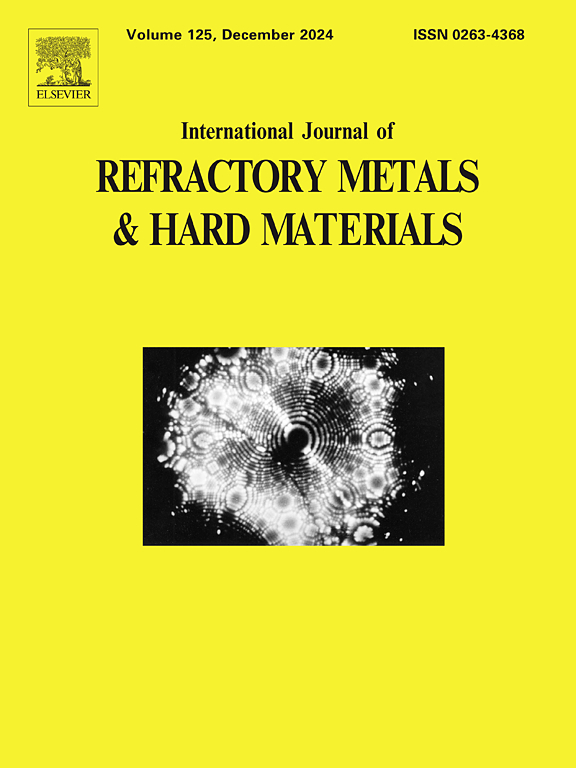Ta2.5W与GH3128电子束焊接接头的组织与力学性能
IF 4.6
2区 材料科学
Q2 MATERIALS SCIENCE, MULTIDISCIPLINARY
International Journal of Refractory Metals & Hard Materials
Pub Date : 2025-07-10
DOI:10.1016/j.ijrmhm.2025.107325
引用次数: 0
摘要
钽和镍合金部件在航空航天领域发挥着至关重要的作用,通过高效的连接技术可以最大限度地发挥其价值。本研究旨在通过显微组织分析来阐明Ta/Ni焊接接头的界面形成机制和断裂行为。在本工作中,采用不同焊接速度的电子束焊接成功地连接了1mm厚的Ta2.5W和GH3128板。系统地研究了焊接接头的力学性能,并进行了详细的显微组织表征。结果表明:Ta2.5W/GH3128焊接接头具有明显的脆性特征,在反应层处连续出现断裂;在实验范围内,焊接速度的增加导致接头抗拉强度的提高。显微硬度分析表明,在应力作用下,焊缝反应层呈硬脆组织,易萌生裂纹。焊接试样断口呈现典型的脆性断裂特征,胞状(Ni3Ta-Ni)共晶组织分布均匀。利用电子背散射衍射进行精细微观结构表征,发现反应层主要由树枝状四方Ni3Ta金属间化合物组成,这种硬脆相显著降低了接头的力学性能。相邻区域也发生了相应的显微组织变化:GH3128侧晶发生了取向重建,施密德因子接近0.5,而Ta2.5W侧晶由于Ni3Ta的形成发生了晶格畸变和位错积累,导致硬度和脆度增加。该研究揭示了反应层内的Ni₃Ta方枝晶的脆性和共晶结构。研究发现,提高焊接速度可以减小反应层厚度,提高接头强度,为研究Ta/镍基合金异种焊接的显微组织-性能关系提供了重要依据。本文章由计算机程序翻译,如有差异,请以英文原文为准。
Microstructure and mechanical properties of electron beam welded Ta2.5W and GH3128 joints
Tantalum and nickel alloy components play a critical role in the aerospace sector, and their value can be maximized through efficient joining techniques. This study aims to elucidate the interface formation mechanism and fracture behavior of Ta/Ni weld joints via microstructural analysis. In this work, electron beam welding with different welding speeds was successfully employed to join 1 mm thick Ta2.5W and GH3128 plates. The mechanical properties of the welded joints were systematically investigated, and detailed microstructural characterization was conducted. Results indicate that Ta2.5W/GH3128 welded joints exhibit distinct brittle characteristics, with fractures consistently occurring at the reaction layer. Within the experimental scope, increasing welding speed led to enhanced tensile strength of the joints. Microhardness analysis revealed that the reaction layer in the weld constitutes a hard and brittle microstructure prone to crack initiation under stress. Fracture surfaces of the welded specimens displayed typical brittle fracture features, with uniform distribution of cellular (Ni3Ta—Ni) eutectic structures. Electron backscatter diffraction was utilized for fine-scale microstructural characterization, identifying that the reaction layer primarily consists of dendritic tetragonal Ni3Ta intermetallic compounds—hard and brittle phases that significantly degrade joint mechanical properties. Concomitant microstructural changes occurred in adjacent regions: GH3128 side grains underwent orientation reconstruction with Schmid factors approaching 0.5, while Ta2.5W side grains experienced lattice distortion and dislocation accumulation due to Ni3Ta formation, resulting in increased hardness and embrittlement. This study reveals the brittle nature of tetragonal Ni₃Ta dendrites and eutectic structures within the reaction layer. It was found that increasing welding speed can reduce the thickness of the reaction layer and enhance joint strength, providing critical insights into the microstructure-property relationship for dissimilar welding of Ta/nickel-based alloys.
求助全文
通过发布文献求助,成功后即可免费获取论文全文。
去求助
来源期刊
CiteScore
7.00
自引率
13.90%
发文量
236
审稿时长
35 days
期刊介绍:
The International Journal of Refractory Metals and Hard Materials (IJRMHM) publishes original research articles concerned with all aspects of refractory metals and hard materials. Refractory metals are defined as metals with melting points higher than 1800 °C. These are tungsten, molybdenum, chromium, tantalum, niobium, hafnium, and rhenium, as well as many compounds and alloys based thereupon. Hard materials that are included in the scope of this journal are defined as materials with hardness values higher than 1000 kg/mm2, primarily intended for applications as manufacturing tools or wear resistant components in mechanical systems. Thus they encompass carbides, nitrides and borides of metals, and related compounds. A special focus of this journal is put on the family of hardmetals, which is also known as cemented tungsten carbide, and cermets which are based on titanium carbide and carbonitrides with or without a metal binder. Ceramics and superhard materials including diamond and cubic boron nitride may also be accepted provided the subject material is presented as hard materials as defined above.

 求助内容:
求助内容: 应助结果提醒方式:
应助结果提醒方式:


